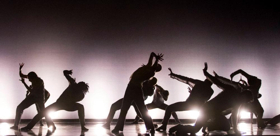Review: Hubbard Street Dance Chicago Performs Crystal Pite

Hubbard Street Dance Chicago, under the direction of Glenn Edgerton, is one of the most accomplished dance companies in the United States today. After an international career with the Joffrey Ballet and later at the Nederlands Dance Theater 1, both as dancer and artistic director, Edgerton brings unique skills to his position. It shows in his company's performances--serious, accomplished and professional--a real mark that the company is a cut above the rest.
The second week of performances at the Joyce Theater, March 12-17, was a triple bill of Crystal Pite's choreography. Pite is a former member of Ballet British Columbia in Vancouver and William Forsythe's Ballet Frankfurt. She has created more than 40 ballets for notable companies, among then Nederlands Dans Theater 1, Cullberg Ballet, Ballet Frankfurt and the National Ballet of Canada.
The opening duet, A Picture of You Falling, presented Jacqueline Burnett alone onstage in dim lights. I felt fortunate to be there. Burnett's performance is strong, clear, and precise. When Elliot Hammans enters, he is charismatic and a good partner for Burnett. Their fluid movements flowed to a background of the spoken word. Original music by Owen Belton, voice by Kate Strong, and lighting design by Robert Sondergaard set the mood. The clever way of using spot-lights to illuminate a dancer, then leave him or her in the dark, created images of memories which came and disappeared in an instant. This was impressive.
The Other You, the second duet on the program, was danced by Michael Gross and Andrew Murdock. There was no music, only sound-effects like wind blowing, sound design by Belton. They are like mirror images which evolve into a movement conversation, action/reaction, still without music. Although silence is not easy to dance to, nor is it easy to hold the attention of the audience, their performance was riveting, with exact, simple movements. Late in the piece, Ludwig van Beethoven's Moonlight Sonata was played, with a large spotlight (seeming like the moon) shining towards the audience. Lighting design was done by Robert Sondergaard.
The last work, Grace Engine, included fifteen dancers. There were lights along the back aimed at the audience, lighting design by Jim French, that shone in the audience's eyes for only brief moments periodically. I am not fond of bright lights in my eyes but was grateful that the effects were not prolonged. Belton again produced sound effects and music. Dressed in dark suits and most in white shirts, the dancers' fluidity was like waves of people. As the piece progressed, the bright lights shone for longer periods, causing not only myself but the people on either side of me to shield our eyes. Whenever I see a performance with bright lights that shine directly at the audience, I wonder why the creator has chosen to punish the audience. We are there, after all, to support the dancers. Unfortunately, these lights have burned right through my memory of anything else worth noting. The lovely lady to my right said she found this work pretentious, but I recalled the burning of the lights.
Photo credit: Todd Rosenberg
Reader Reviews

Videos
